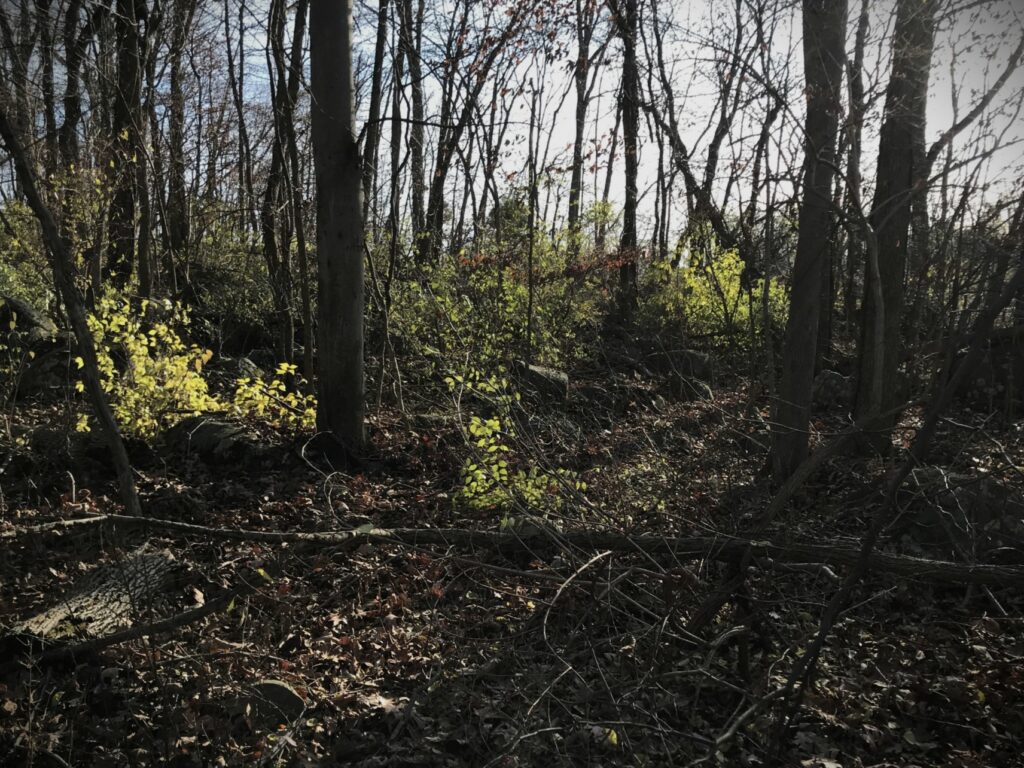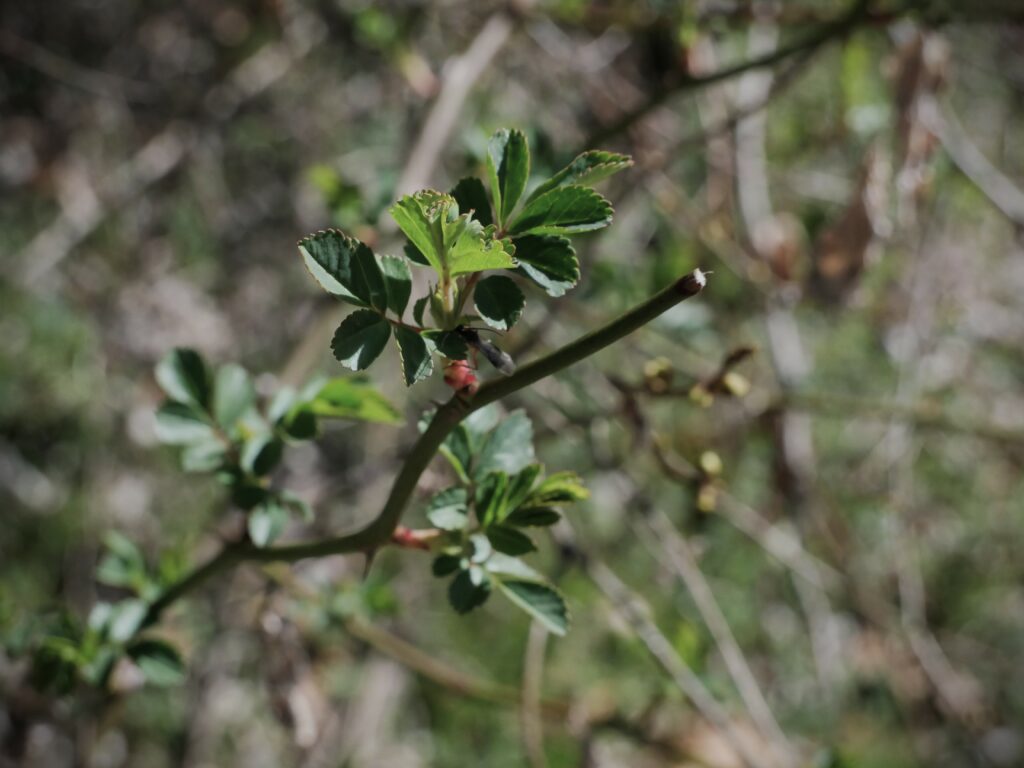By Keith Williams, Vice President of Engagement & Education
The woods are getting darker, darker. It’s near dusk, but it seems like the sunlight is disappearing especially quickly tonight, the night of October 31st. The woods become eerily still. No wind, no animals, no birds or insects. No sound. You push on. You must find the reported cluster of invaders to eliminate them. The season for your efforts to be effective is closing.
It feels like you’re being watched. You stop periodically to silence your footsteps that crunch through leaves so you can listen, but there is never anything to see or hear. Just dark woods.

Bush honeysuckle (Photo by Keith Williams)
You start to notice signs: smooth gray trunks, covered in black soot. These tree of heaven trunks indicate that you are entering a previously disturbed part of the forest, and then before you appears an endless expanse of nothing but bush honeysuckle! The striped gnarled trunks arch over your head, eliminating whatever light is left. They give this part of the forest a sinister feel. There is no other life here – just bush honeysuckle.
Bush honeysuckle is one of several plants that are considered invasive. They take over our native ecosystems, reduce the diversity of native species, and create a monoculture which disrupts ecosystem function and eliminates the native diversity. They completely change the feel, texture, complexion, and ecological resilience of a place.
Invasives are usually not from the region where they invade, so normal population controls like disease and herbivory (organisms eating plants) or predation (organisms eating animals) don’t exist in their new geographies. In the case of plants, this allows the invader populations to launch and outcompete the native species for light, water, and nutrients. There are instances where the invader secretes phytotoxic compounds to eliminate competitors in a kind of plant community chemical warfare.
Invasives get into our ecosystems through a variety of routes, but they are often introduced on purpose. Many invasive plants are landscape ornamentals that escaped captivity, like this looming thicket of bush honeysuckle.
You frantically – but carefully – use loppers to cut the smaller stems of the honeysuckle and a hand saw to eliminate the larger one. Then you straighten up and survey the woods around you, searching for signs of hope. You are disheartened to see only two native shrubs on this half-acre patch of forest, and no seedlings. In the presence of the bush honeysuckle, there will be no forest regeneration, and the future of this site is just a tangle of invasives. You are the first line of defense, and you have to intervene.
You cut a swath through the honeysuckle. This path will give the Lancaster Conservancy Volunteer Land Steward crew the access they need to finish the job of eliminating this patch of bush honeysuckle, which is the first step in restoring native ecology and biodiversity. Diverse ecosystems are more resilient to disturbance and maintain ecosystem functions that we depend on like nutrient cycling and pollination. Satisfied that you’ve made progress combatting these invaders, you start to hike up the steep slope back through the patch of honeysuckle. It’s much more extensive than you thought, but still, you’re making good time, beating total darkness, and feeling proud of the work you’ve accomplished.
Suddenly, you jerk to a stop. Your right foot is trapped by something! You drop to the forest floor, struggling to get free. A thick oriental bittersweet vine has you snared.
Oriental bittersweet is a stunning vine, another landscape escapee. No wonder these are landscape favorites – they grow beautiful yellow berries that turn orange and crimson through the winter, throwing sprays of color to the tops of tree canopies through the gray months of the year. The same things that make it attractive make it lethal. The vines climb to the tops of the forest canopy, strangulate the trees beneath, and starve them of light, which causes forest canopy collapse, and the forest becomes a jumbled mass of vines rather than towering trees that reach for light. And those beautiful berries? They are a favorite food of some birds who defecate the seeds through the forest, spreading the canopy killers even further. The fact that the vine roots wherever it touches the ground makes it hard to kill, but you hack through this one in a few places any way. One thing is for sure: if you don’t cut it, it is sure to thrive.

Multiflora rose (Photo by Avery Van Etten)
With your foot free, you fumble through the now-dark forest…and get caught in multiflora rose, like a fly in a web! The thorns on the long straight fronds rip your clothes and puncture the skin of your forearms. These were new hiking pants! Now it’s personal.
You slash the wide bush to a stump in no time with your loppers. Farmers were encouraged to plant hedgerows of multiflora rose in the ‘40s and ‘50s to prevent wind erosion and provide small game habitat. It got into the adjacent woods and took over. Now we have stands of rose with nothing growing beneath it. At least sunlight will reach the forest floor where this trap of a rose bush used to stand.
You continue to hike out of the woods, now under the early light of the moon, passing numerous multiflora rose bushes and bush honeysuckles, climbing bittersweets, and other invasives like garlic mustard and burning bush. The invasives are so abundant, the native diversity so suppressed, that for a moment, it feels like your efforts were enormously futile. Fighting invasives can make you feel like Don Quixote tilting at windmills – all that misguided energy seemingly wasted.
But then you come upon a patch of land that a volunteer crew cleared last year – a patch that was nothing but rose, bittersweet, and honeysuckle that is now multiple species of native goldenrods, milkweeds, white avens, and snake roots. Young hickories, locusts, and an oak or two almost top the herbaceous layer. And shrubs like spice bush and sassafras are coming back. All that expended energy made a difference for this one-acre patch, and all the energy that will be expended will make a difference for even more acres of our natural lands. This part of the forest will be cleared of invasives, and maybe native diversity will once again reign. You smile to yourself and leave the nature preserve feeling optimistic, and a little hungry for some Halloween candy.
